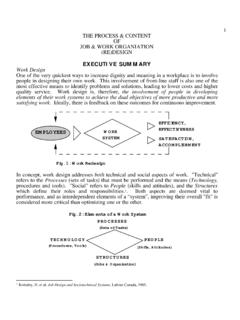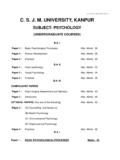Transcription of THE EVOLUTION OF REGULATORY POLICY IN OECD …
1 The EVOLUTION of REGULATORY POLICY in OECD countries nick malyshev OECD 1 THE EVOLUTION OF REGULATORY POLICY IN OECD countries nick malyshev organisation for Economic Co-Operation and Development In the past 20 years a key topic of public sector reform in OECD countries has been the emergence of REGULATORY POLICY . During this period, the nature of regulation has undergone profound and rapid change. It evolved from early efforts of eliminating regulation and gave way to more systemic REGULATORY reform, involving a mixture of de-regulation, re-regulation and improving the effectiveness of regulations. However, these initial formulations of REGULATORY reform often assumed that change was episodic in nature.
2 Moreover, they aimed to restore a REGULATORY structure to some ideal state through a one-off set of interventions. Experience demonstrated that such views were untenable and they gave way in turn to the concept of REGULATORY management. REGULATORY management differed in seeing the process of reform as being a dynamic one. With time, the process became increasing integrated into public POLICY making. Today, almost all OECD countries have established explicit institutions and tool to implement REGULATORY POLICY . As with other core government policies, such as a monetary or fiscal POLICY , REGULATORY POLICY is an integral role of government and is pursued on a permanent basis.
3 This paper documents the development of the REGULATORY POLICY agenda. It reviews policies, tools and institutions adopted in OECD countries , identifying the most promising practices as well as less successful History The history of regulation is not one of coherent government strategy, but rather of reactions to the changing objectives and requirements in different countries , industries, and POLICY contexts. Following the rapid growth in the scope and scale of REGULATORY interventions through most of the twentieth 1 This paper draws extensively from REGULATORY Policies in OECD countries . From Interventionism to REGULATORY Governance, Paris, 2002 and a series of OECD REGULATORY Reform Reviews, available at ,2578,en_2649_37421_1794487_1_1_1_37421, The EVOLUTION of REGULATORY POLICY in OECD countries nick malyshev OECD 2 century, shifts in the economic environment began to reveal more clearly the previously hidden costs of out-dated, low quality and constantly expanding REGULATORY structures.
4 Yet, while the problems caused by poor quality regulation were increasingly apparent, reform was consistently being delayed or blocked. For many years, the complexity of reform and uncertainty about its expected results blocked progress. This was due in part to POLICY fragmentation in the structure of government. Governments lacked the co-ordination and planning capacities necessary to move forward with horizontal packages of policies and reforms. Governments also gave too little attention to reviewing, updating, and eliminating unnecessary or harmful regulation. Many regulations currently on the books date from periods earlier in 20th century when economic and social conditions were very different from what they are today.
5 Incentive structures within bureaucracies did not encouraged effective and accountable use of POLICY . Incentives too often favoured vocal rather than general interests, short-term rather than long-term views and the use of traditional controls rather than innovative approaches. Vested interests were able to block needed reform, even when the benefits to society at large were vastly larger (though diffuse) than the concentrated (and highly visible) costs to the interest group. Most government officials were not equipped to assess the hidden costs of regulation or to ensure that REGULATORY powers were used cost-effectively and coherently. The locus of REGULATORY authority also became diffuse.
6 REGULATORY powers increasingly were exercised at sub-national or supra-national levels. This increased the tendency for duplicative, conflicting, or excessive regulations to arise, as co-ordination between different sources of REGULATORY power was often rudimentary or non-existent. In sum, a complex array of factors fuelled what is now called REGULATORY inflation. At the same time, few efforts were made to develop an understanding of the nature of regulation as a POLICY tool. The emergence of deregulation and REGULATORY reform in the 1970s constituted some of the first attempts to address this question of the nature of regulation, and its limits as a POLICY tool.
7 But the need to better understand the regulation was not at the heart of the reform agenda at that time. The first efforts at deregulation were driven by economic downturn and were based on the view that a too great a quantity of regulation was impeding the economy by strangling innovation and entrepreneurialism. However, these early attempts at deregulation were, at best, only partially successful. But as the process continued, as deregulation gave way in the 1980s and 1990s first to REGULATORY reform, then to REGULATORY management and, more recently, to the developing a REGULATORY POLICY agenda. Deregulation was superseded by REGULATORY reform and then by REGULATORY management quite early in the development of the current REGULATORY POLICY agenda.
8 This change entailed a shift away from questions of what regulation should be eliminated and toward how REGULATORY structures could be improved in terms of design and functioning. Over time, the key elements of REGULATORY quality management emerged from the experiences of the reformers. Attempts to promote REGULATORY quality were first focused on identifying important areas of poor quality regulation, advocating specific REGULATORY reforms and scrapping burdensome regulations. Increasingly it was recognised that ad hoc approaches to reform were insufficient. The size of the task required co-ordinated action on many fronts, while the benefits of consistent approaches and the wide application of POLICY learning, were too substantial to be foregone.
9 The EVOLUTION of REGULATORY POLICY in OECD countries nick malyshev OECD 3 Thus, the reform agenda began to broaden to include the adoption of a range of explicit overarching policies, disciplines and tools. These became permanent, rather than episodic in nature. At the broadest level, this shift has meant providing explicit POLICY support for the REGULATORY reform agenda, by adopting a reform POLICY at the whole of government level, often with timelines, targets and evaluation mechanisms. It has also included the adoption of consistent approaches to the rule-making process and the implementation of new POLICY tools such as the use of REGULATORY impact analysis, administrative simplification and REGULATORY alternatives.
10 Perhaps most importantly, the adoption of REGULATORY policies has meant that responsibility for elements of the programme has been allocated to specific government agencies. REGULATORY Policies REGULATORY POLICY is the systematic development and implementation of government-wide tools and institutions used to shape the on how governments use their REGULATORY powers. This includes i ntegrati ng compet ition poli c y and mar ket openne ss i niti ati ve i n the r e gulat or y polic y a ge nda and c ha ngi ng the culture of regulators so that flexibility and outcome oriented approaches are s yst e matic all y f a voure d i n re gula tor y de sign. All re gul ator y pol icies ar e bas ed on a mi x of e conomi c, le gal , a nd public ma na ge me nt principles.

















